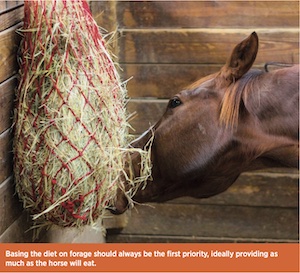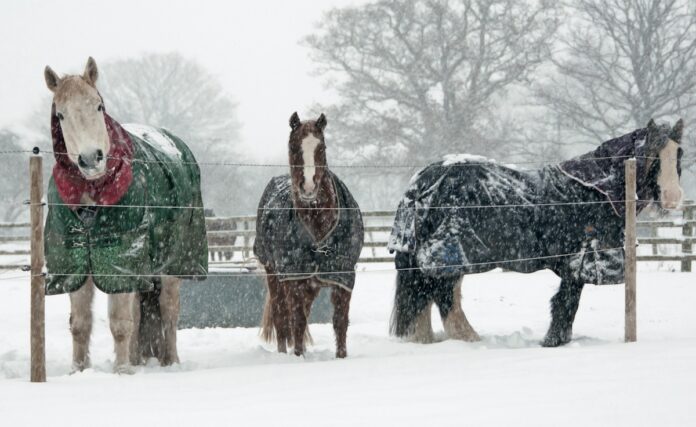Why fibre is favourite...

AMTRA is required by the Veterinary Medicines Regulations to ensure its RAMAs/SQPs undertake CPD. All RAMAs/SQPs must earn a certain number of CPD points in a given period of time in order to retain their qualification. RAMAs/SQPs who read this feature and submit correct answers to the questions below will receive two CPD points. For more about AMTRA and becoming a RAMA/SQP, visit www.amtra.org.uk
To some owners, the advice to feed a high fibre diet may feel like old news, but its importance should never be underestimated. Sarah Nelson, SPILLERS nutritionist, explains why fibre is critical to the health and well-being of all horses.
WHAT IS FIBRE?

The term fibre describes a group of nutrients called structural carbohydrates. Depending on their type, feeds and forages contain varying amounts of digestible, partially digestible and indigestible fibre.
The fermentation of fibre in the large intestine or ‘hindgut’ produces volatile fatty acids which are absorbed into the bloodstream and utilised as a source of energy or ‘calories’.
Highly digestible or ‘rapidly’ fermentable’ fibres yield the greatest amount of energy, while slowly fermentable fibres yield the least.
SOURCES OF FIBRE
The majority of fibre in every horse’s diet should ideally be provided by forage, but for those unable to maintain weight on forage alone, fibre ‘in the bucket’ provides a valuable source of additional energy/calories.
Certain ingredients can sometimes cause alarm, but the key
is to provide a balance of fibre sources most appropriate for the individual horse or pony. For example, feeds based on sources of slowly fermentable fibre such as wheatfeed, oatfeed and straw, are often ideal for good doers because they are low in calories.
On the other hand, feeds or ingredients high in rapidly fermentable fibre such as soya hulls and sugar beet are significantly more digestible and may be better suited to poor doers or horses in hard work, especially if fed in larger amounts.
TIP: Remember horses that are unable to manage long fibre (grass, hay and haylage) will need a forage replacer and where possible, owners should include at least some short-chopped fibre to help increase chewing. However, those with very poor teeth will need a mash, potentially fed as 100% of the diet.
HOW MUCH FIBRE DO HORSES NEED?
Unlike many other nutrients, there’s no published requirement or ‘recommended daily intake’ for fibre per se in horses. Basing the diet on forage should always be the first priority, ideally providing as much the horse will eat, while being mindful of excess waste.
However, this may not be appropriate for good doers, especially if they are overweight. In 2016, a group of researchers, vets and nutritionists from the EU and the UK published recommendations for minimum daily forage intake based on 20 years of scientific research, agreeing that for most horses, total intake should not be restricted to less than 1.5% of current bodyweight per day on a dry matter basis.
The term dry matter often causes confusion, but this recommendation is equivalent to owners needing to weigh out approximately 9kg of hay (11kg if it is to be soaked before feeding) or 11-12kg of haylage (sometimes more) for a 500kg horse without grazing.
For horses unable to maintain weight on forage, choosing fibre- based feeds containing low or restricted amounts of cereal starch and sugar will help to support digestive health and reduce the risk of unwanted excitability (cereal starch is the most common cause of feed related excitability).
FIBRE FOR HINDGUT HEALTH
A high fibre diet is essential for maintaining hindgut health and ultimately, a healthy digestive system is the foundation of a healthy horse.
Low fibre and/or high starch diets may lead to or contribute to weight loss, loose droppings and several clinical conditions including colic and tying up.
FIBRE FOR GASTRIC HEALTH
When it comes to reducing the risk of gastric ulcers, one of the main benefits of feeding forage and short chopped fibre is to promote chewing.
The horse’s stomach produces acid continuously (although at a variable rate). Saliva provides a natural buffer to stomach acid but unlike people, horses only produce saliva when they chew, which is why long periods without eating increases stomach acidity. However, feeding short chopped fibre prior to exercise can also help to prevent ‘gastric splashing’.
Exercise increases abdominal pressure, causing acid to ‘splash’ on to the stomach lining in the non-glandular region where it increases the risk of ulcers forming. Feeding short chopped fibre helps to prevent gastric splashing by forming a protective ‘fibre mat’ on top of the contents of the stomach.
Current advice is to feed 2 litres of short chopped fibre (by volume - equivalent to 1 Stubbs scoop) in the 30 minutes before exercise.
TIP: suggest customers add short chopped fibre to every meal and ideally one containing alfalfa, as the high protein and calcium content is thought to help buffer stomach acid.
Did you know?
- In one study, the risk of non-glandular ulcers was found to be approximately 4 times higher in horses left more than 6 hours without forage, although the risk may be higher during the day.
- Recent research found that adding 15% short chopped fibre to meals significantly increased eating time.
FIBRE FOR MENTAL WELL-BEING
Having evolved to spend up to 16-18 hours per day foraging, horses have a psychological as well as a physiological need to chew.
This considered, it may come as no surprise that studies have found a link between low forage diets and a higher prevalence of stereotypical behaviours such as crib biting.
However, feeding short chopped fibre can help to promote positive behaviour too - in one study, three of out five foals stopped or showed a reduction in crib-biting when given feeds designed to increase chewing.
FIBRE FOR CENTRAL HEATING
The fermentation of fibre in the large intestine produces heat which is often described as a source of ‘central heating’ that will help to keep horses warm in winter months.
Although the digestion of fibre produces heat regardless of the season, diets based on winter pasture, hay and haylage (as opposed to fresh spring/ summer grazing) are generally higher in fibre and less digestible and in turn, produce more heat.
FIBRE FOR HYDRATION
Depending on the type of diet, fluid in the horse’s digestive system may account for around 9-21% of the horse’s bodyweight. The ‘reservoir’ of fluid in the large hindgut is thought to provide a source of water that can be drawn upon during brief periods of short supply and may be influenced by the amount and type of fibre fed.
For example, research in the 1990s found horses fed a high forage diet were less dehydrated after a standard exercise test than those fed a diet that included limited forage; while other studies indicated that alfalfa has a higher water holding capacity and is more digestible than mature grass hays.
Mashes have become increasingly popular in recent years and of course, any feed that requires soaking will help to support hydration.
ABOUT ETN’S RAMA/SQP FEATURES

ETN’s series of CPD features helps RAMAs (Registered Animal Medicines Advisors/SQPs) earn the CPD (continuing professional development) points they need. The features are accredited by AMTRA, and highlight some of the most important subject areas for RAMAs/ SQPs specialising in equine and companion animal medicine.
AMTRA is required by the Veterinary Medicines Regulations to ensure its RAMAs/SQPs undertake CPD. All RAMAs/SQPs must earn a certain number of CPD points in a given period of time in order to retain their qualification. RAMAs/SQPs who read this feature and submit correct answers to the questions below will receive two CPD points. For more about AMTRA and becoming a RAMA/SQP, visit www.amtra.org.uk











